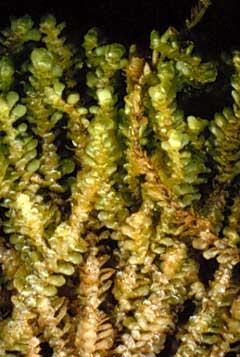| Jungermanniales | ||
|---|---|---|
| Rango temporal: Pérmico Superior[1] hasta hoy | ||
 Una hepática foliada, Scapania sp. | ||
| Taxonomía | ||
| Reino: | Plantae | |
| División: | Marchantiophyta | |
| Clase: | Jungermanniopsida | |
| Subclase: | Jungermanniidae | |
| Orden: |
Jungermanniales H.Klinggr, 1858[2] | |
| Subórdenes | ||
Jungermanniales es el orden más numeroso de Marchantiophyta, conformado por miles de especies y con características morfológicas comunes.
Familias de Jungermanniales
Jungermanniales se clasifica en cuatro subórdenes y las siguientes familias:[3]
Cephaloziineae
Jungermanniineae
- Acrobolbaceae
- Antheliaceae
- Arnelliaceae
- Balantiopsidaceae
- Blepharidophyllaceae
- Calypogeiaceae
- Delavayellaceae
- Endogemmataceae
- Geocalycaceae
- Gymnomitriaceae
- Gyrothyraceae
- Jackiellaceae
- Jungermanniaceae
- Myliaceae
- Solenostomataceae
- Trichotemnomataceae
Lophocoleineae
- Brevianthaceae
- Herbertaceae
- Lepicoleaceae
- Lepidoziaceae
- Lophocoleaceae
- Mastigophoraceae
- Phycolepidoziaceae
- Plagiochilaceae
- Pseudolepicoleaceae
- Trichocoleaceae
- Vetaformataceae
Perssoniellineae
Referencias
- ↑ Oostendorp, Cora (1987). The Bryophytes of the Palaeozoic and the Mesozoic. Bryophytorum Bibliotheca 34. Berlin & Stuttgart: J. Cramer. p. 18. ISBN 3-443-62006-X.
- ↑ Klinggräff, Hugo von (1858). Die höheren Cryptogamen Preussens. Königsberg: Wilhelm Koch. p. 10.
- ↑ Jungermanniales NCBI taxonomy database
Enlaces externos
 Wikispecies tiene un artículo sobre Jungermanniales.
Wikispecies tiene un artículo sobre Jungermanniales.








